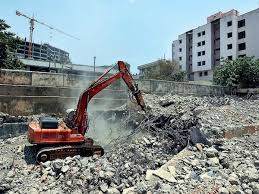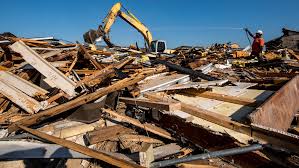Construction and demolition debris, often referred to as C&D debris, is a broad category of waste materials generated from construction, renovation, and demolition activities.
It includes various materials such as concrete, wood, metal, drywall, asphalt, bricks, and other construction-related materials. Proper management and disposal of C&D debris are essential to minimize environmental impact and promote recycling and reuse of these materials.
Construction and demolition debris, or C&D debris for short, might not sound fancy, but it’s a big deal in the world of waste management and environmental conservation. Let’s break it down in simple terms.
What is C&D Debris?
C&D debris is basically all the stuff that gets left behind when buildings are built, renovated, or torn down. Imagine a construction site or a house being demolished, what is left after the work is done is C&D debris.
What is in it?
C&D debris is like a mixtape of materials. You’ve got things like concrete, wood, metal, drywall, asphalt, bricks, and more. Basically, it’s a jumble of stuff that used to be part of buildings.
Why does it matter?
Here is the deal: C&D debris can be a real environmental headache if not handled properly. When it piles up in landfills, it takes up space and can even harm the environment. But there’s good news, C&D debris can also be a goldmine of reusable and recyclable materials.
Read Also: Best Mattress Waste (Old Mattress) Management Method
The Green Side of C&D Debris

1. Recycling: Many materials in C&D debris, like concrete and metal, can be recycled and used to build new things. This saves resources and energy.
2. Reusing: Sometimes, items like doors, windows, or fixtures can be salvaged and reused in other projects, reducing the need for new materials.
3. Reducing Waste: Proper management of C&D debris reduces the amount of waste ending up in landfills, which is great for the planet.
4. Economic Benefits: Recycling and reusing C&D debris can create jobs and save money compared to buying new materials.
What can you do?
If you are involved in construction or demolition, here are some steps you can take to make C&D debris work for the environment:
1. Plan Ahead: Think about recycling and reusing from the start of your project.
2. Separate Materials: Keep different types of materials separate to make recycling easier.
3. Find Recycling Facilities: Look for local facilities that accept C&D debris for recycling.
4. Educate Workers: Make sure everyone on your team knows the importance of proper debris management.
C&D debris might be messy, but it’s also an opportunity. By handling it wisely, we can reduce waste, save resources, and build a more sustainable future. So, let’s keep our construction and demolition projects green and clean!
Proper Management of Construction and Demolition
Managing construction and demolition debris (C&D debris) the right way is like being a superhero for the environment. Let’s explore the simple but powerful steps to make it happen.
1. Plan Wisely: Before you swing that first hammer or start tearing down walls, have a game plan. Think about how you’ll handle C&D debris. Here’s what to consider:
2. Design for Deconstruction: If possible, design buildings so that materials can be easily taken apart and reused when the time comes.
3. Set Recycling Goals: Decide how much of the debris you’ll recycle and what materials can be salvaged.
4. Sort and Separate: Once the work begins, sort and separate the materials. It’s like sorting your recycling at home, but on a larger scale.
5. Keep It Clean: Make sure debris is clean of contaminants like paint or chemicals.
6. Separate by Type: Keep different materials separate, concrete with concrete, wood with wood, and so on.
7. Reuse and Recycle: Now, it is time to work some magic with those materials.
8. Reuse: Check if any items like doors, windows, or fixtures can be reused in your project or in others.
9. Recycle: Send materials like concrete, metal, and wood to recycling facilities. They can be turned into new things, reducing the need for fresh resources.
10. Find the Right Facilities: You need a partner in this green mission. Find local facilities that accept C&D debris for recycling. They’re like the recycling centers for your project’s materials.
11. Educate Your Team: Share the importance of proper C&D debris management with your crew. Make sure everyone understands why it matters and how to do it right.
12. Track Your Progress: Keep an eye on how much debris you’re recycling and reusing. This helps you stay on track with your goals and shows your commitment to sustainability.
13. Green Benefits: Proper C&D debris management isn’t just about being kind to the environment. It comes with rewards;
14. Economic Savings: Recycling and reusing can often be cheaper than buying new materials.
15. Environmental Protection: Reducing landfill waste and conserving resources benefits the planet.
16. Job Creation: Recycling and reusing efforts can create jobs in your community.
17. Regulations and Permits: Check local regulations and get the necessary permits for handling C&D debris. Following the rules keeps your project on the right side of the law.
Managing C&D debris the right way isn’t rocket science, but it’s a powerful way to build responsibly. It helps save money, protect the environment, and create a more sustainable future. So, let’s be the superheroes that our planet needs by managing C&D debris properly, one project at a time!
Read Also: Strategies for Managing Clothing Waste
Construction and Demolition Debris Recycling

Construction and demolition debris recycling is like turning trash into treasure for the environment. Let’s dive into the world of C&D debris recycling in plain and simple language.
What Is C&D Debris Recycling?
Think of C&D debris recycling as a way to give a second life to materials that might otherwise end up as waste. Instead of tossing these materials in landfills, we sort, clean, and reuse or remake them into something new.
The Recycling Process
1. Collection and Sorting: First, we gather up all the debris from construction or demolition sites. It’s like gathering puzzle pieces.
2. Separation: Now, the magic happens. We sort the debris into different types: concrete, wood, metal, and so on. It’s a bit like sorting laundry, making sure everything goes where it belongs.
3. Recycling: Each sorted pile is sent to special facilities. They have machines that can turn these materials into something useful again. For example:
Why Should We Recycle C&D Debris?
Recycling C&D debris is a win-win situation for everyone:
1. Environmental Friendliness: It reduces the strain on natural resources and lessens the waste in landfills.
2. Cost-Effective: Recycling often costs less than buying new materials, which can save money for builders and contractors.
3. Job Creation: Recycling facilities create jobs, benefiting local communities.
The Power of Reuse
Recycling isn’t the only option. Sometimes, materials like doors, windows, or fixtures can be saved and reused in other projects.
Closing the Loop; Buying Recycled Products: Once C&D debris is recycled, it can be used to make new products. You can be part of the cycle by buying items made from recycled materials, like recycled paper, plastic, or construction materials. This supports the whole recycling process.
Your Role in C&D Debris Recycling
If you are involved in construction or demolition, here’s how you can make a green impact:
1. Plan Ahead: Include recycling in your project plan from the start.
2. Sort Smartly: Make sure debris is separated by type, so recycling is easier.
3. Partner with Recycling Facilities: Find local facilities that accept C&D debris for recycling.
4. Spread the Word: Educate your team about the importance of recycling C&D debris.
C&D debris recycling isn’t just about saving the planet; it’s about being smart, cost-effective, and environmentally responsible. It’s like giving Mother Earth a high-five while saving money and resources.
Read Also: All You Need to Know About Cosmos Flower

